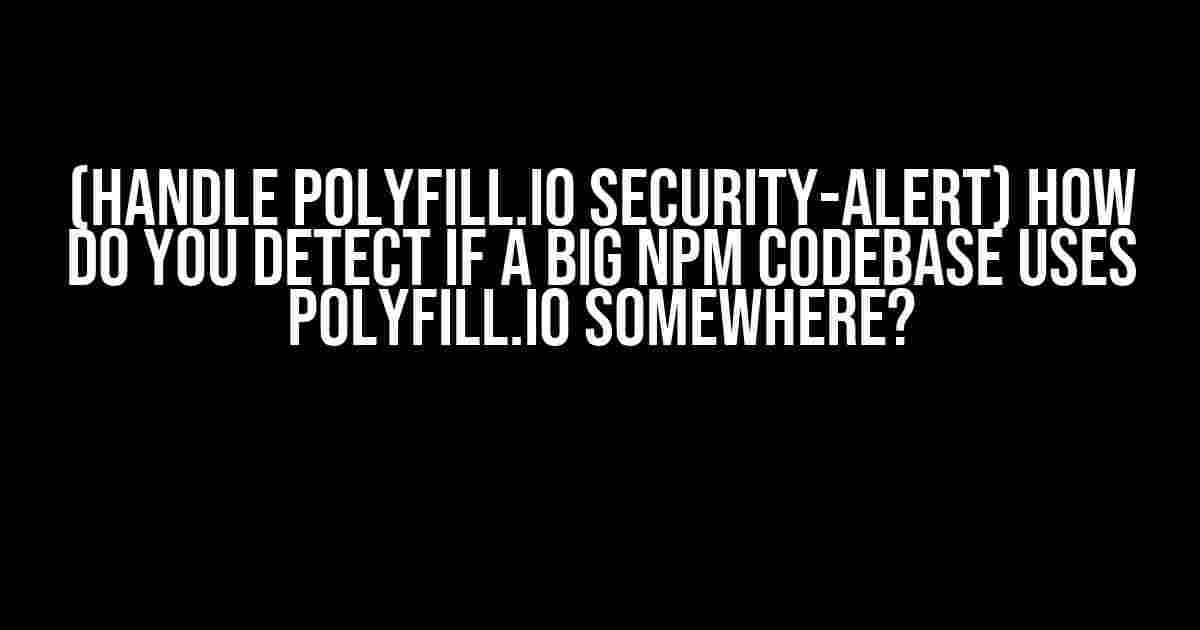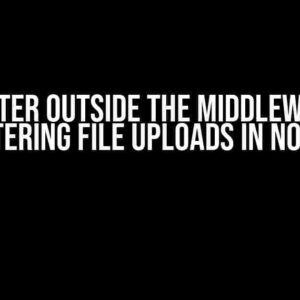Are you a developer who’s ever received a frantic security alert from your team, only to embark on a wild goose chase to detect if your massive npm codebase uses Polyfill.io somewhere? Well, put on your detective hat, because we’re about to dive into the world of efficient Polyfill.io detection!
What is Polyfill.io, and why should I care?
Polyfill.io is a service that provides polyfills for a variety of features, allowing developers to write modern JavaScript code that works across different browsers and versions. While it’s a useful tool, it can also introduce security vulnerabilities if not used properly. That’s why it’s essential to detect and address any Polyfill.io usage in your codebase.
Why is detecting Polyfill.io usage a challenge?
In a large npm codebase, it can be difficult to identify if Polyfill.io is being used, especially when there are numerous dependencies and sub-dependencies. Here are some reasons why detection can be a challenge:
- Indirect dependencies: Polyfill.io might be used by a dependency of a dependency, making it hard to track.
- Minified and uglified code: Some dependencies might be minified or uglified, making it challenging to search for specific strings.
- Obfuscated code: Malicious actors might intentionally obfuscate their code to avoid detection.
Detecting Polyfill.io usage: Methods and Tools
Now that we understand the challenges, let’s dive into the methods and tools you can use to detect Polyfill.io usage in your npm codebase:
Method 1: Manual Search (The Old-School Way)
This method involves manually searching for specific strings in your codebase. You can use the following search queries:
grep -r "polyfill.io" .
grep -r "cdn.polyfill.io" .
grep -r "polyfill.io/v" .
These searches will look for mentions of Polyfill.io in your codebase. However, this method has its limitations:
- Time-consuming: Searching through a massive codebase can take hours.
- Prone to errors: You might miss instances or false-positives.
Method 2: Using npm-audit (The npm Way)
npm-audit is a built-in npm tool that helps identify security vulnerabilities in your dependencies. You can use it to detect Polyfill.io usage:
npm audit --json --production
This command will generate a JSON report, which you can parse to detect Polyfill.io usage. You can also use the `–polyfill-io` flag:
npm audit --json --production --polyfill-io
However, this method has some limitations:
- Not all Polyfill.io instances might be detected.
- npm-audit might not detect indirect dependencies.
Method 3: Using Snyk (The Pro Way)
Snyk is a popular open-source security tool that provides comprehensive vulnerability detection. You can use Snyk to detect Polyfill.io usage:
snyk test
Snyk will generate a report detailing vulnerabilities, including Polyfill.io usage. You can also use Snyk’s `–print-deps` flag to detect indirect dependencies:
snyk test --print-deps
Snyk provides a more accurate and efficient way to detect Polyfill.io usage, but it requires registration and setup.
Method 4: Custom Scripting (The Ninja Way)
If you’re comfortable with scripting, you can create a custom script to detect Polyfill.io usage. Here’s an example script using Node.js and npm-registry-client:
const npa = require('npm-registry-client');
async function detectPolyfillIo() {
const registry = npa();
const packages = await registry.list('/-/all');
packages.forEach((pkg) => {
const deps = pkg.dependencies;
Object.keys(deps).forEach((dep) => {
if (deps[dep].includes('polyfill.io')) {
console.log(`Polyfill.io detected in ${pkg.name}@${pkg.version}`);
}
});
});
}
detectPolyfillIo();
This script will recursively search through your dependencies and detect Polyfill.io usage. You can modify the script to suit your specific needs.
Handling Polyfill.io Security Alerts
Once you’ve detected Polyfill.io usage, it’s essential to address the security alerts. Here are some steps to take:
- Identify the vulnerable dependency: Determine which dependency is using Polyfill.io and its version.
- Check for updates: Look for updates to the vulnerable dependency that address the security issue.
- Update the dependency: Update the vulnerable dependency to the latest secure version.
- Test and verify: Test your codebase to ensure the update has resolved the security alert.
- Monitor and maintain: Regularly monitor your codebase for Polyfill.io usage and maintain a secure development workflow.
Conclusion
Detecting Polyfill.io usage in a large npm codebase can be a daunting task, but with the right methods and tools, you can efficiently identify and address security alerts. Remember to stay vigilant and maintain a secure development workflow to ensure the integrity of your codebase.
| Method | Description | Pros | Cons |
|---|---|---|---|
| Manual Search | Search for specific strings in codebase | Easy to implement | Time-consuming, prone to errors |
| npm-audit | Use npm-audit to detect security vulnerabilities | Easy to implement, built-in tool | Not all Polyfill.io instances might be detected |
| Snyk | Use Snyk to detect Polyfill.io usage and vulnerabilities | Comprehensive vulnerability detection, accurate results | Requires registration and setup |
| Custom Scripting | Create a custom script to detect Polyfill.io usage | Flexible, customizable, efficient | Requires scripting knowledge, maintenance |
Choose the method that best suits your needs, and remember to stay proactive in detecting and addressing Polyfill.io security alerts.
Frequently Asked Question
Got questions about handling Polyfill.io security alerts in a big npm codebase? We’ve got answers!
What’s the best way to detect if a large npm codebase uses Polyfill.io somewhere?
One effective way to detect Polyfill.io usage is by running the command `grep -r “polyfill.io” *` in the terminal. This command searches for the string “polyfill.io” in all files within the codebase, helping you identify potential uses of Polyfill.io.
Can I use npm dependencies to detect Polyfill.io usage?
Yes, you can use npm dependencies to detect Polyfill.io usage. Run the command `npm ls polyfill.io` to check if Polyfill.io is listed as a dependency in your project. Additionally, you can use tools like `npm-audit` or `snyk` to scan your dependencies for potential security vulnerabilities, including Polyfill.io.
How do I scan for Polyfill.io usage in a large codebase with multiple dependencies?
To scan for Polyfill.io usage in a large codebase with multiple dependencies, use tools like `code-grep` or `ripgrep` (rg) to search for polyfill.io in your code. You can also use `npm-dependency-tree` to visualize your dependency tree and identify potential uses of Polyfill.io.
What if I’m using a JavaScript bundler like Webpack or Rollup? Can I still detect Polyfill.io usage?
Yes, even with a JavaScript bundler like Webpack or Rollup, you can still detect Polyfill.io usage. Check your bundler’s configuration files (e.g., `webpack.config.js` or `rollup.config.js`) for any mentions of Polyfill.io. You can also use plugins like `webpack-bundle-analyzer` or `rollup-plugin-visualizer` to analyze your bundle and identify potential uses of Polyfill.io.
What’s the next step after detecting Polyfill.io usage in my codebase?
After detecting Polyfill.io usage, review the affected code and assess the potential security risks. Consider updating or patching the vulnerable dependencies, and follow best practices for securing your codebase. You may also want to notify your team and stakeholders about the potential security issue and collaborate on a plan to resolve it.





